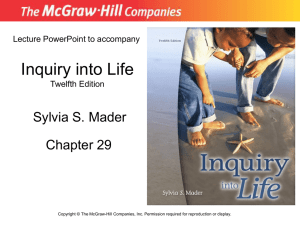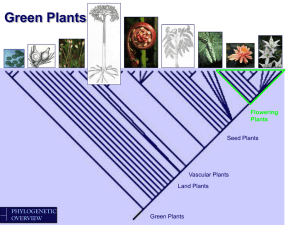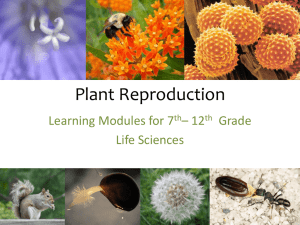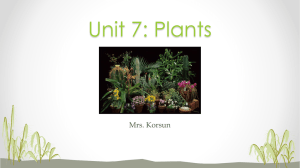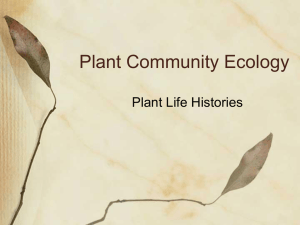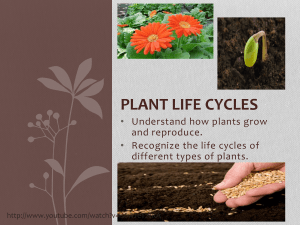Seed Plants - Mr. Wright`s Class Website
advertisement
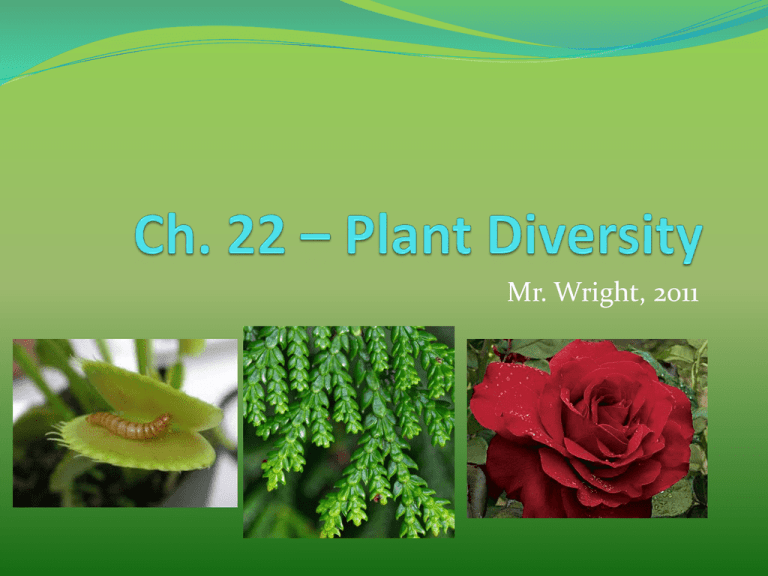
Mr. Wright, 2011 Plant Diversity We are going to be spending the next couple of weeks looking at the basic characteristics of plants. As you will see, there is a lot of diversity in this kingdom… they are more than “just plants”. Today we are going to watch a video that shows some pretty unique and interesting plants, and you will see just how diverse this kingdom is! Section 22.1 The Kingdom Plantae In order to be classified as a plant, an organism MUST be: Multicellular Eukaryotic Cell walls made of cellulose (sugar) Autotrophic (photosynthesis) Plant Life Cycles Plants, like the protists and fungi we’ve talked about before, go through alternation of generations during their life cycles. Plants have both a haploid and a diploid stage. In plants, these stages have special names. Plant Life Cycles Gametophyte – a haploid individual that produces gametes. These gametes will combine to form the diploid sporophyte. Sporophyte – A diploid individual that produces haploid spores through meiosis The spores then grow into gametophytes. Evolution of Plants The first plants evolved from algae. Algae spend their whole lives in water, while plants evolved to live on land. In order to survive on land, plants needed to be able to do three things. Three adaptations for land: Plants need to be able to absorb nutrients from their surroundings. Plants evolved roots for just this purpose. The very first plants did not have roots. Instead, they got their nutrients from symbiotic fungi (mycorrhizae). Three adaptations for land: Plants need to be able to prevent water loss to keep from drying out. Plants evolved a waxy, watertight covering called a cuticle. Three adaptations for land: Plants need to be able to disperse (spread) themselves across dry land. Several ways plants can do this: Wind Water Other Organisms Plant Groups Plants evolved to form 4 main groups. We will look at in terms of seedless plants and seed plants. Daily Assignment – Comparing Plants The next three slides will include pictures of two different plants. Look at each plant. How are they different? How are they similar? Make a Venn Diagram for each pair of plants to show these similarities/differences in a handy dandy graphic organizer. Comparing Plants Maple Tree Elm Tree Comparing Plants Gingko Tree Pine Tree Comparing Plants Venus Fly Trap Apple Tree Section 22.2 and 22.3 Seedless Plants Seedless plants are the most primitive plants. They can be divided into two smaller groups: Nonvascular (bryophytes) Vascular The very first plants were nonvascular seedless plants, and vascular plants evolved from there. Nonvascular Plants - Bryophytes These plants do not have vascular tissue (veins) to transport water throughout the organism. Examples include mosses, liverworts, and hornworts. Nonvascular Plants - Bryophytes Water is transported through the plant by osmosis and diffusion. This means water moves very slowly and over short distances. This limits the size of these plants – they simply can’t move water far enough quickly enough to grow large. Vascular Plants An important step in the evolution of plants was the development of vascular tissue (veins). This is what makes it possible for plants to move food and water over great distances, allowing them to grow tall. The most well known member of this group are ferns. Vascular Plants Two types of vascular tissue: Xylem – transports water through a plant Phloem – transports food (nutrients and sugars) through a plant Daily Assignment – Nonvascular and vascular plants under the microscope I have set up several microscopes with a variety of slides on them. Some of the slides are from nonvascular plants, and some are from vascular plants. Complete the worksheet given to you and turn it in for today’s grade. Should look something like this… Sections 22.2 and 22.3 Daily Assignment – Diagramming a Seedless Life Cycle Color the gametophyte stage one color, and the sporophyte stage another. Be sure to include a key so I know which is which. Be sure to label all parts, particularly the archegonium, egg, antheridium, sperm, zygote, sporangium, and spores. In your own words, describe what is happening at each step in the table provided. Reproduction in Seedless Plants Plants produce both male gametes (sperm) and female gametes (eggs) – sometimes both on the same plant! Haploid! These are produced by specialized structures on the haploid gametophytes. Reproduction in Seedless Plants Archegonium – the female reproductive structure in plants, produces a single egg. Reproduction in Seedless Plants Antheridium – the male reproductive structure in plants, produces sperm cells Reproduction in Seedless Plants In seedless plants, the sperm cells need to reach the egg cell somehow. The only way they can do this is if there is water covering the plant for them to swim through. REQUIRE WATER TO REPRODUCE!!!!! Reproduction in Seedless Plants The two gametes will combine to form a zygote (fertilized egg). This grows into the diploid sporophyte. Reproduction in Seedless Plants Sporangium – a specialized structure where spores are produced in the sporophyte Spores are produced by meiosis, so they are haploid. Will grow into new gametophytes. Reproduction in Seedless Plants Thus a cycle is formed, and it repeats over and over again! Weekly Wrap-up Activity Daily Assignment – Act It Out You will work in a group of 4-6 people of your choosing. You MAY want to try to have both genders represented. This week, we have spent a lot of time talking about the most basic plants - the seedless plants. Before we begin talking about plants with seeds, I’d like to review everything we’ve done up to this point. General Plant Characteristics Nonvascular vs. Vascular plants The Life Cycle of a Seedless Plant I will give each group one of the topics listed above. Daily Assignment – Act It Out Your group will then create a play/skit about the topic given to you. Skits should be fairly short… 5 minutes maximum. Every group member must be involved in some manner. Props - anything in my room is yours to use. How you set your play up is your choice – maybe you will play the plants themselves, or maybe your play takes place in a classroom. Be creative and maybe you can have some fun with it. You will perform these at the end of class, which gives you about 30 minutes to get things put together. You may write a script, if you like, but it’s for your own use only… your grade will be on the performance itself. Section 22.4 Seed Plants - Groups Seed plants are divided into two smaller groups – gymnosperms and angiosperms. Both of these groups are vascular plants, and they all produce seeds to aid in the survival and dispersal of their offspring. Seed Plants - Groups The difference between the two groups is how they develop their seeds – angiosperms have fruit, while gymnosperms do not. Gymnosperm = “naked seed” Angiosperm = “covered seed” Seed Plants - Reproduction Seed plants do NOT require water to reproduce. They have other methods for getting sperm and egg cells together. Because of this fact, they can live almost anywhere, including very dry areas. Seed Plants - Reproductions Plants have both male and female parts. They often look completely different from each other, as do the structures they are kept in. Seed Plants - Reproduction In seed plants, male gametes are kept in side of pollen grains. They don’t have to swim towards the egg… instead, they are carried by something else. Wind Insects Animals Pollination – when the pollen is carried to the female structure. Seed Plants - Reproduction A tube emerges from the pollen grain and attaches to the ovule, allowing sperm to travel into the egg. This is fertilization. The fertilized ovule will then develop into a seed. Plants CAN self-pollinate. Seed Plants - Reproduction A seed is a fertilized embryo surrounded by a protective layer and food supply. Protective layer = seed coat Not only protects it, but keeps it from drying out Gymnosperms – Cone Bearers Gymnosperms are conifers. Any plant that does not have its seeds inside of fruit falls in this classification. Many types of trees, but not all. Daily Assignment: Seed Plant Reproduction On a blank piece of paper, put the following steps in order. Draw a picture of each step as you go. A tube emerges from the pollen grain and attaches to the ovule. Antheridia produce sperm cells in the form of pollen grains, while archegonia/ovaries produce egg cells in the form of ovules. Pollen grains land on the female reproductive structure. The ovule is fertilized and becomes a seed. Pollen grains are picked up by something (wind, animals, water) and carried elsewhere. The seed results in a new plant being formed. Complete the vocabulary review crossword puzzle. Staple both pages together and turn them in for today’s grade. Section 22.5 Angiosperms Angiosperms develop unique reproductive organs known as flowers. Thus, they are known as the flowering plants. These attract insects and animals to aid in pollination. Angiosperms Flowers have ovaries which surround and protect the seed. After fertilization, these ovaries swell up and develop into fruit. This aids in dispersal – the plant wants it to get eaten so that it can be carried far distances before getting pooped out. Classifying Angiosperms Angiosperms are divided into two classes based on their seeds – the monocots and dicots. Monocots – have one seed leaf (called a cotyledon) Dicots – have two seed leafs Monocots vs. Dicots Besides the difference in the number of seed leaves, there are other differences between these two groups as well. Monocots usually have parallel venation, while dicots have net venation. Monocots vs. Dicots Monocot flowers tend to have their parts in multiples of 3, while dicot flower parts tend to be in multiples of 4 or 5. Monocots vs. Dicots Monocots tend to have fibrous root systems, while dicots tend to have one large taproot. Daily Assignment – Fruit Lab Today, we will look at many different types of fruit. We will attempt to tell how they are classified based on what we can see inside the fruit. Follow the instructions on the lab worksheet given to you and turn in once finished. Please be careful with the fruit given to you as supplies are limited. Once you are finished you may eat what you have if you want to. Enjoy! Section 24.1 Structure of a Flower Structure of a Flower Stamen – the male reproductive structure of a flower that produces pollen and consists of an anther at the tip of a filament Anther – the tip of a stamen, which contains the pollen sacs where pollen grains are formed. Filament – holds the anther Structure of a Flower Pistil – the female reproductive part of a flower that produces seeds and consists of an ovary, style, and stigma. Also known as carpals Structure of a Flower Ovary – contains the ovules, where eggs are produced. Style – a narrow stalk coming off of the ovary Stigma – sticky place at the top of the style where pollen lands Structure of a Flower Petals – brightly colored tissue surrounding the reproductive parts. Designed to attract insects and other pollinators. Sepals – small green leaves below the petals These are what cover the bud and protect the flower before it opens. Daily Assignment: Flower Dissection Today you will dissect a flower and look at the different parts that it has. Follow the instructions on the lab sheet and fill out the information as you go along. RULES FOR DISSECTING: Thou shalt not screw around with the scalpel – if you do, I’ll take it from you, you’ll get a zero, and you won’t be doing any more dissections this year. Thou shalt keep all materials on thy towel and dispose of them when finished. Thou shalt clean up after thyself. Thou shalt not eat anything. Section 25.2 and 25.3 Tropisms The responses of plants to external stimuli are called tropisms. Greek for “turning” Think of it as plant behavior. Tropisms Gravitropism Stems will ALWAYS grow against the force of gravity. Roots will ALWAYS grow with the force of gravity. In other words, stems always grow up and roots always grow down. Tropisms Phototropism Plants will always grow towards a light source. Some plants will even turn during the day to face the sun at all times. Tropisms Thigmotropism Response to touch. Examples: Vines use it to wrap around another tree. Leaves may fold closed when touched. Venus fly trap’s close shut when hairs are triggered. Winter Dormancy Dormancy – the period in which a plant’s growth and activities stop. Photosynthesis becomes less effective, so plants stop those pathways altogether. Leaves become pointless, so the plant is better off without them… they lose too much water! Chlorophyll disappears, causing change in color. All sugars and water are extracted from the leaves. The plant is completely sealed off from the plant and eventually will fall off. Nutrition Specialists Why are some plants carnivorous? These plant still do photosynthesis. However, they live in nitrogen-poor environments, and they need that nitrogen to survive. Thus, they have evolved to get it from other sources. Nutrition Specialists Parasites Some plants extract water and nutrients directly from other plants at their expense. Some parasitic plants don’t even have chlorophyll! These rare cases would be plants that are NOT autotrophic. Example: Daily Assignment: Vocabulary Review Time! We have gone through a lot of new vocabulary this chapter, as usual. This seems to be what trips people up the most so we are going to spend some extra time on it this time around. We will do this by playing a vocabulary game: ASK ENGLISH DEPARTMENT FOR VOCABULARY GAME IDEAS!!!
